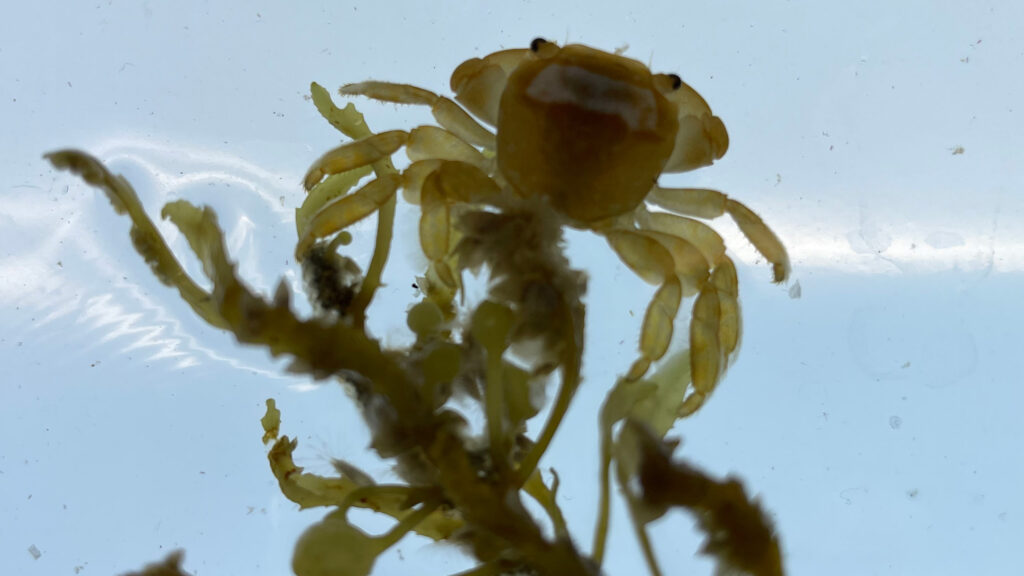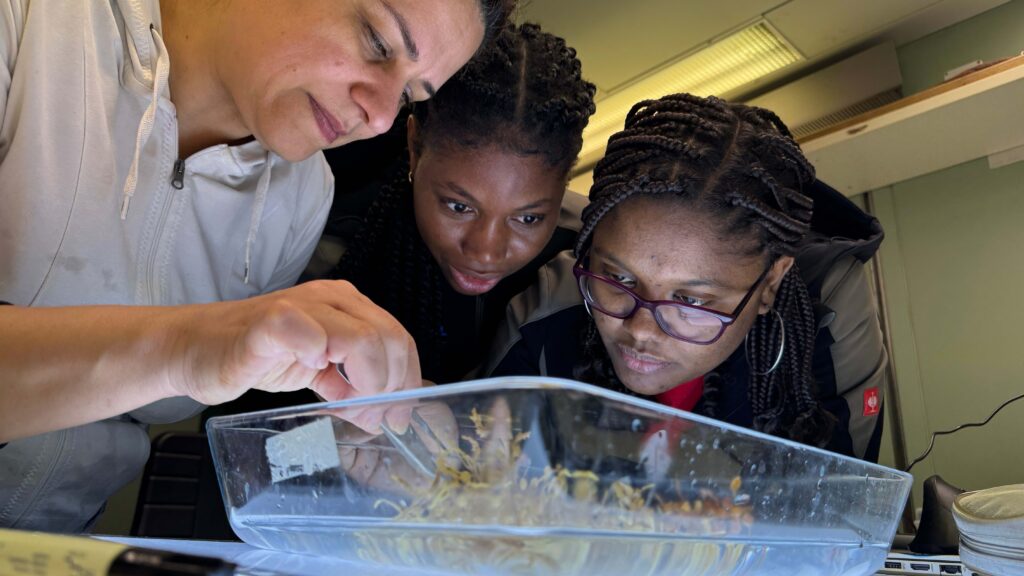Flap! Flap! Coo…. These pigeon noises, perfectly normal in any congested city, are entirely unexpected here. We are sailing through the eastern tropical North Atlantic on the German icebreaker POLARSTERN that is our home for two weeks. Water to the horizon in all directions and then… a pigeon! A quick look to portside solves the mystery – in the distance the island of Tenerife passes slowly by, doubtless the home port of our stowaway.
(German version below)
Soon our massive floating home comes to a halt and the nautical officer declares that we were “on station”, code for “time to let instruments over board”. This is a special station, the European Station for Time-Series in the Ocean (ESTOC), a spot in the ocean at which continuous measurements of ocean properties have been taken since 1994. How else is one to identify changes in the ocean that document climate change effects fueled by humans?
On board our Floating University are 15 trainees, of which 13 are from West African countries. With some oversight from their instructors they deploy instruments to measure, for example, physical properties and take samples in the water column. One small and important contribution to a valuable global data set!
Not long after, we see our chief scientist Björn Fiedler, helmeted and armed with a 4-m hooked rod, shuffling down the railing, his sights on the water surface. He is calling out to marine ecologist Jamileh Javidpour, who is also leaning over the railing though with a more conventional sampling gear, a small plankton net. Soon a seaman joins with his own contraption (self-made tool) and suddenly it becomes clear that they are trying to collect small clumps of algae that are floating past the ship’s rump. “Now!”, “Get it!” – “Oh No!” “another one coming”… and with an efficient swoop the net comes up with a handful of macroalgae. We have sampled sargassum, the ubiquitous algae that form huge mats in the central tropical North Atlantic, aka the “Sargassum Sea”. Taking a ride on this mat is our second stowaway, a 3-cm Portunus sayi a sargassum crab camouflaged into the algae. Barnacles, plankton, fish eggs and countless other co-passengers are attached to the sargassum and have made it on board the POLARSTERN.


At the end of the day our pigeon has vanished, doubtlessly on the fastest aerial route home. The crab is still on board. We can’t return it to the water without its algal infrastructure; without its own “ship” to hold on to it would face a free fall of several kilometers to the sea bed.
The POLARSTERN continues on its way to its home port of Bremerhaven, the Canary Islands fall behind us and we resume our work as usual after this short interlude.
Avan Antia
Blinde Passagiere
Flap! Flap! Coo…. Diese Taubengeräusche, die in jeder überfüllten Stadt völlig normal sind, sind hier völlig unerwartet. Wir segeln durch den östlichen tropischen Nordatlantik auf dem deutschen Eisbrecher POLARSTERN, der für zwei Wochen unser Zuhause ist. Wasser bis zum Horizont in alle Richtungen und dann… eine Taube! Ein kurzer Blick nach Backbord löst das Rätsel – in der Ferne zieht langsam die Insel Teneriffa vorbei, zweifellos der Heimathafen unseres blinden Passagiers.
Bald kommt unser massives schwimmendes zu Hause zum Stillstand und der nautische Offizier erklärt, dass wir „auf Station“ sind, was so viel bedeutet wie „Zeit, die Instrumente ins Wasser zu lassen“. Es handelt sich um eine besondere Station, die Europäische Station für Zeitreihen im Ozean (ESTOC), eine Stelle im Ozean, an der seit 1994 kontinuierlich Messungen der Meereseigenschaften vorgenommen werden. Wie sonst soll man Veränderungen im Ozean feststellen, die die Auswirkungen des vom Menschen verursachten Klimawandels dokumentieren?
An Bord unserer schwimmenden Universität befinden sich 14 Studierende und 1 Schüler, von denen 13 aus westafrikanischen Ländern stammen. Unter Anleitung ihrer Lehrenden setzen sie Instrumente ein, um z.B. physikalische Eigenschaften zu messen und Proben in der Wassersäule zu nehmen. Ein kleiner und wichtiger Beitrag zu einem wertvollen globalen Datensatz!
Kurz darauf sehen wir unseren wissenschaftlichen Fahrtleiter Björn Fiedler, behelmt und mit einer 4 m langen Angel bewaffnet, über die Reling schlurfen, die Wasseroberfläche im Visier. Er ruft der Meeresökologin Jamileh Javidpour zu, die sich ebenfalls über die Reling lehnt, allerdings mit einem eher konventionellen Probenahmegerät, einem kleinen Planktonnetz. Bald gesellt sich ein Seemann mit seinem eigenen Gerät dazu, und plötzlich wird klar, dass sie versuchen, kleine Algenklumpen zu sammeln, die am Rumpf des Schiffes vorbeischwimmen. „Now!“, “Get it!“ – „Oh nein!“ „Da kommt noch was“… und mit einem effizienten Schwung taucht das Netz mit einer Handvoll Makroalgen auf. Wir haben Sargassum beprobt, die allgegenwärtigen Algen, die im zentralen tropischen Nordatlantik, auch bekannt als „Sargassum-Meer“, riesige Matten bilden. Auf dieser Matte reitet unser zweiter blinder Passagier, ein 3 cm großer Portunus sayi, ein in den Algen getarnter Sargassum-Krebs. Seepocken, Plankton, Fischeier und zahllose andere Mitreisende kleben am Sargassum und haben es an Bord der POLARSTERN geschafft.
Am Ende des Tages ist unsere Taube verschwunden, zweifellos auf dem schnellsten Luftweg nach Hause. Die Krabbe ist noch an Bord. Ohne ihre Algeninfrastruktur können wir sie nicht ins Wasser zurückbringen; ohne ein eigenes „Schiff“, an dem sie sich festhalten kann, droht ihr ein freier Fall von mehreren Kilometern auf den Meeresgrund.
Die POLARSTERN setzt ihren Weg zum Heimathafen Bremerhaven fort, die Kanarischen Inseln liegen hinter uns und wir nehmen nach diesem kurzen Zwischenspiel unsere Arbeit wie gewohnt wieder auf.
Avan Antia
